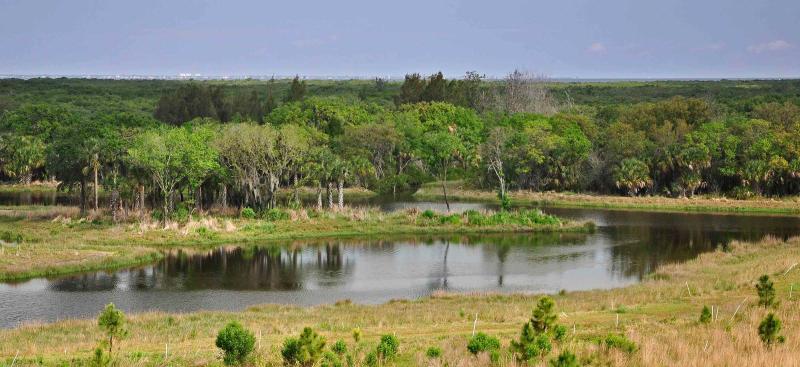The Southwest Florida Water Management District, in cooperation with Hillsborough County, completed the largest habitat restoration project ever done in the history of Tampa Bay.
Project Background
Since 2009, the District’s Surface Water Improvement and Management (SWIM) program has been working to design and construct the largest coastal restoration project ever performed for Tampa Bay. This project is a cooperative effort between SWIM and the Hillsborough County Conservation and Environmental Lands Management Department.
Located on three public parcels in the southeastern reaches of Tampa Bay (adjacent to “Cockroach Bay”), the project involves sites that historically were coastal pine flatwoods, scattered hardwood hammocks, and various estuarine and freshwater habitats. Use of the upland areas for agricultural purposes and sand/shell mining removed the majority of the historic plant communities and habitat values from these parcels.
Restoration Activities and Benefits
The project involves the restoration of approximately 1,043 acres of various coastal habitats, including 645 acres of uplands, such as pine flatwoods and hardwood hammocks, and 398 acres of various estuarine and freshwater habitats. The estuarine habitats include: 1) open water tidal channels and lagoons, 2) low and high intertidal marshes, 3) islands, 4) sand/mud flats, 5) deeper water “holes,” 6) natural limestone artificial reefs, and 7) more than 16 miles of new Tampa Bay shorelines. Cascading freshwater wetlands include both permanent pools as well as ephemeral freshwater habitats.
In addition, the project creatively helps restore the area’s hydrology, improves the bay’s water quality via some stormwater treatment, creates fisheries habitats including salinity gradients and low-salinity habitats, and supplements important bird nesting and feeding habitats.
Equally important, the project design will help accommodate projected sea-level rise. This project complements the SWIM/Hillsborough County Cockroach Bay Ecosystem Restoration Project located on the north side of Cockroach Bay, a 500-acre habitat restoration project completed in 2012.
Project Facts
- Total number of upland and wetland plants installed = 981,477.
- Total volume of dirt moved to enhance/create wetlands = 1.6 million cubic yards, which is the equivalent of stacking dirt 611 feet high on a football field. (That’s taller than the 42-story Bank of America Plaza skyscraper in Downtown Tampa.)
- The largest volunteer marsh planting in the history of Tampa Bay (by number of plants) was held November 14, 2015, with 289 volunteers installing 40,000 marsh plugs in new intertidal marsh platforms in two hours.
- In total, 24 volunteer events (including two Boy Scout Eagle Projects) have involved 1,503 volunteers installing 158,033 marsh plants, with additional events proposed for 2016 and 2017.
- Early evidence of project success includes widespread observations of:
- recreational and commercially important fish, including snook, mullet and tarpon;
- bird nesting, roosting and feeding (e.g., terns, plovers, oyster catchers, great egrets, roseate spoonbills, sandhill cranes, glossy ibis, white pelicans, bald eagles, ospreys);
- invertebrates (e.g., blue crabs, fiddler crabs, grass shrimp);
- mammals (otter, bottlenose dolphin, whitetail deer, bobcat);
- widespread recruitment of seagrasses to the estuarine lagoons, which is very important for fish and other wildlife;
- establishment of salinity gradients and low-salinity habitats, which helps increase diversity in the estuary and serve as important fish nursery areas.
- Lastly, this project is one of 96 SWIM coastal restoration projects performed with cooperators since 1989 for a cumulative total of 4,617 acres (7.2 square miles of coastal habitats) of restored habitat mosaics for the Tampa Bay coastal ecosystem.

